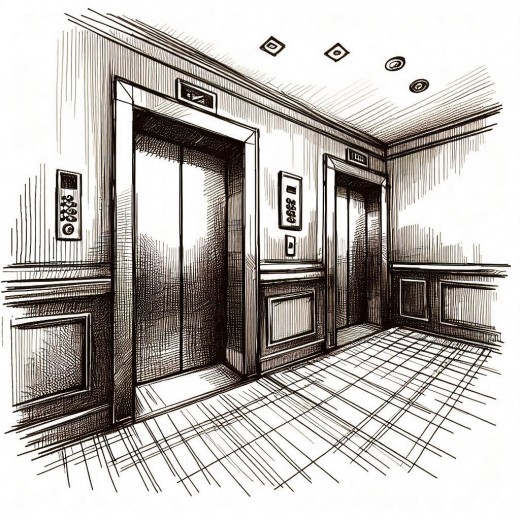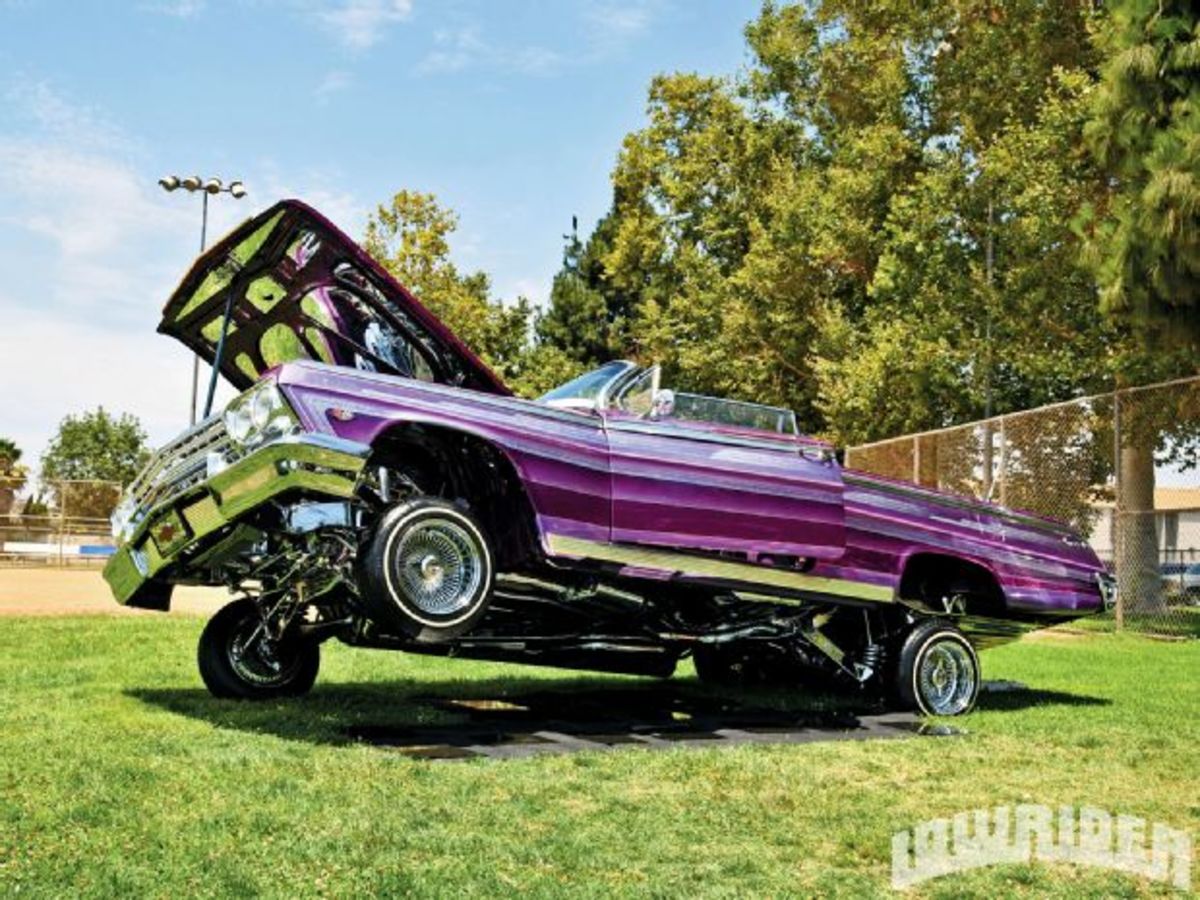Elevator
Various types of hoists powered by human labor, animals, or waterpower were used from ancient times to raise and lower loads. After about 1800, steam engines were used to power hoists. However, these hoists were used almost exclusively for freight because of the constant danger of the rope s breaking and allowing the platform to fall.
The first commercial elevators were built in 1850. However, they were very crude and ran only between two floors. The first practical safety device for hoists was demonstrated in 1852 by an American, Elisha Graves Otis, who built a safety hoist for the bedstead factory where he was master mechanic. In Otis' safety hoist the lifting rope was attached to a wagon spring on top of the hoist frame. The pull of the rope bent the spring and retracted cams on each side of the frame. This kept the cams from engaging the ratcheted guide rails on which the platform ran. If the ropes broke, the spring straightened out, forcing the cams to engage the guide rails and stop the platform from falling. In 1853, Otis went into the business of manufacturing hoists with the wagon-spring safety.
The first real passenger elevator was installed by Otis in 1857 in a store in New York. Early elevators used steam engines for power. The first Otis elevators used winding drums driven by belts from the engine. In 1859, Otis introduced an elevator with a reversible steam engine directly connected to the winding drum by belt and gear.
The first hydraulic elevators were installed in 1878. These elevators were similar to modern hydraulic elevators. The car was attached to the end of a plunger that fitted into a cylinder sunk into the ground. The plunger and car were moved upward when water was forced into the cylinder under pressure. When water was released, the car descended. In another type of hydraulic elevator, the plunger and cylinder pulled ropes that raised and lowered the car.
The first electric elevator was installed in 1889. The modem gearless traction electric elevator was developed hi 1903. Automatic elevators with simple control systems and suitable for use in private residences became available as early as 1894. More advanced control systems were introduced in 1924, and in 1949 the first fully automatic elevators able to handle traffic in tall, busy buildings were put into service.

Modern Elevators
Modern elevators are either electric or hydraulic. Buildings of five or fewer stories, where the elevators are relatively slow, generally have the hydraulic type, while buildings taller than five stories usually have electric elevators. The fastest electric elevators, such as those in the 102-story John Hancock Center in Chicago, move at speeds up to 1,800 feet (550 meters) per minute.
Electric Elevators. Modern electric elevators are for the most part traction elevators, in which the car is raised and lowered by an electric motor that turns a grooved wheel, or drive sheave, at the top of the elevator hoistway. The drive sheave is attached to the drive shaft of the motor. Steel cables run from the top of the elevator car up the hoistway, over the drive sheave, and down the hoistway to the counterweight. The counterweight balances the car plus about 40% of the load of the car, so that the motor lifts only part of the load. The downward pull of the car and the counterweight holds the cables tight against the sheave so that they will move when the sheave turns. For added traction a secondary sheave is used, and the cables are wrapped around it and the drive sheave. Both the car and the counterweight have roller guides that run along the guide rails on the walls of the hoistway.
Long flexible cables, called traveling cables, run from the control and power systems at the top of the hoistway to the elevator car. These cables contain all the electrical circuits for the car. Power lines supplying electricity to operate the doors, fans, and lighting for the car are in this cable, as are the circuits to the control system.
In the safety system of electric elevators there is a cable attached to the side of the car that turns a governor at the top of the hoistway. If the governor, turns too rapidly, a safety switch is thrown automatically, which sets a brake on the drive sheave. If the brake fails to stop the descent of the car, the governor grips the governor cable. This makes safety clamps on the car wedge against the guide rails, bringing the car to a controlled stop.
Hydraulic Elevators. In a hydraulic elevator the weight of the car and its load is supported from below by a steel plunger, which moves in a vertical cylinder. The cylinder must extend below ground to a depth equal to the height that the elevator rises in the building. Because of this requirement, hydraulic elevators are not installed in very tall buildings.
In the hydraulic elevator a pump, driven by an electric motor, forces oil under pressure into the cylinder to raise the car. When the car is descending, the motor and pump are idle, while electrically controlled valves release oil from the cylinder so that the car can descend.
Safety systems that clamp the car to the rails are not necessary on hydraulic elevators. There is a buffer at the bottom of the hoistway. If the cylinder should begin to leak oil, the
pressure would drop slowly, and the elevator car would descend at a safe speed to the bottom of the hoistway where it would be stopped by the buffer.
Installation. Elevators are assembled at the jobsite. First the installer usually erects the vertical guides. Then the machine-room equipment is put in place, the car frame and cab assembled in the hoistway, and the doors set. Roping and electrical wiring are done last. Elevators are generally made of standardized parts, with each complete installation engineered for the specific job.
Car Types. Passenger elevators have relatively wide, shallow cars with wide entrances, so that people can enter and leave quickly at each stop. The height, width, and depth of other types of elevators vary with their use. For example, hospitals generally have at least some elevators with eep, narrow cars, which are used to carry stretchers, wheelchairs, and portable apparatus from floor to floor.
Observation Elevators. In areas of scenic interest observation elevators running along the outside of buildings and observation towers are becoming increasingly popular. These elevators have walls of transparent glass. Their operating equipment is weatherproof.
Elevator Systems
Electric and hydraulic elevators have been developed in suitable designs, sizes, and speeds for a broad range of modern buildings. Depending on the size of the building, there are one or more elevators that are large and fast enough to provide quick, comfortable transportation during usy periods. On the average, there should be one elevator for approximately every 250 persons in a building of six floors or more.
For fast, frequent service in a tall or busy building, several elevators are necessary, arranged in one or more groups of from three to eight cars. When a building has more than 15 or 20 stories, there are usually 2 or more banks of elevators separated into local and express groups. Express elevators to the higher floors bypass floors served by local cars and move at faster speeds to reduce travel time and provide greater carrying capacity.
Automatic Control. Most modern elevators operate completely automatically. Automatic elevators are both more economical and more efficient than manually controlled ones. The elevator control system regulates the starting and stopping of an elevator. It also controls and coordinates the opening and closing of doors at each stop. Door closing is also controlled by light-ray and rubber-edge safety devices or by electronic proximity detectors, which prevent the doors from closing when someone is in the way.
To use an automatic elevator, passengers operate "up" or "down" buttons at each landing or numbered buttons inside the car. As the elevator moves up in the hoistway, it stops automatically when it reaches a floor where someone has pressed the "up" button or for which a passenger has pressed the button in the car. When the elevator has answered the highest call, it may automatically reverse direction and then stop at the floors where "down" buttons have been pushed.
If a building is tall enough or traffic heavy enough to require a. group of elevators, their operation is automatically coordinated by a group supervisory system, which is a type of electronic computer. As buttons are operated at landings and in cars, resulting electrical data on elevator traffic are processed electronically to control the elevators. The computerized control system automatically keeps the elevators distributed among the various floors so that a car is near each floor or traveling toward traffic demands.
Special Systems. In very tall buildings special systems using high-speed elevators have been devised so that the number of elevators necessary can be kept within a reasonable limit. Without such systems more elevators would be needed and there would be too much valuable floor space lost on hoistways.
The use of high-speed elevators increases carrying capacity without increasing hoistway space. The automatic control systems for these elevators include special circuits that limit change of acceleration and retardation rates so that passengers hardly feel the motion.
Special sky-lobby or double-deck elevator systems, or a combination of both, are being used in the tallest new buildings to minimize elevator space requirements. With the sky-lobby system, a tower is treated like a layer cake of two or three buildings, one on top of the other. For service in the lowest layer, elevators run up from the main lobby in the usual way. The lowest floor of each upper layer is a "sky lobby," which is reached by fast, roomy express elevators that run nonstop from the main floor. At the sky lobby passengers take local elevators to their floors. The hoistways for these local elevators begin at the sky lobby instead of at the main floor, thus in the stories below the sky lobby this area is available as floor space.
Double-deck elevator cars are used to increase the passenger-carrying capacity without requiring larger hoistways. Double-deck elevators can increase passenger capacity by from 25% to 50%. Passengers enter the two decks from two levels, most commonly the street floor and the basement or mezzanine. Escalators are used to link the two levels involved. Double-deck elevators serve two floors with each stop, thus reducing travel time and increasing the number of passengers carried per trip.
Dumbwaiters and Lift Systems
In addition to regular elevators, many hospitals, libraries, and industrial buildings have automatic dumbwaiters, or material lifts, to carry trays, carts, books, or other supplies from floor to floor.
Modern dumbwaiters are small-scale electric elevators. Like automatic elevators, dumbwaiters stop automatically at various floors in response to buttons that have been pushed. Some modern dumbwaiters also have automatic load transfer devices, and supplies are automatically loaded and unloaded, attendants placing the load in front of the lift and operating the call button.
Some special lifts are integrated with conveyor belts in systems that are automatically coordinated and controlled. In these systems loads can be automatically transferred to a selected location on another floor. Automatic controls may also be set to repeat continuous cycles of delivering and returning loads to and from various floors and stations.
This content is accurate and true to the best of the author’s knowledge and is not meant to substitute for formal and individualized advice from a qualified professional.
© 2010 Bits-n-Pieces








